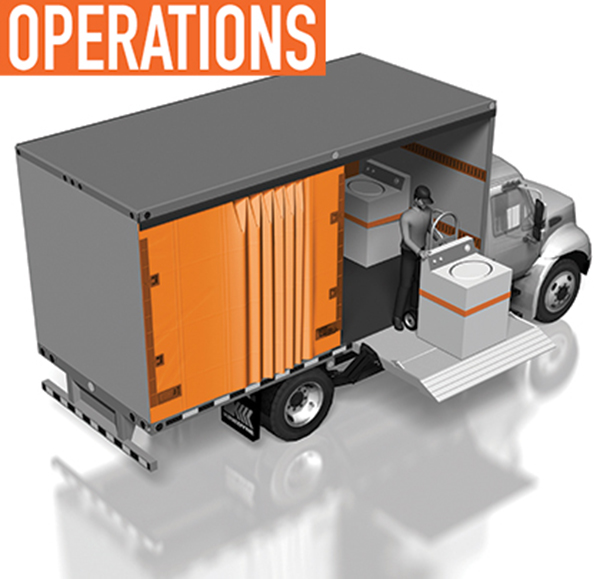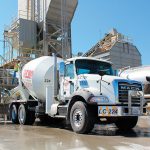Individuals and companies along the supply chain continuum are beginning to make logistics decisions at the moment an online sale is made, and these decisions often travel all the way back to a product’s constituent origins. Transporting raw materials to manufacturing/processing facilities, finished goods on to warehouses, and finally to their ultimate destination is becoming more complex and interdependent every day.
Intermodal players include marine carriers, air carriers, rail carriers, truckload carriers, less-than-truckload (LTL) carriers, and a diverse array of final-mile delivery vehicles. In the beginning, e-commerce had the greatest disruptive effect on end-of-the-line, also known as “final mile” or “last mile” delivery activities, but now companies throughout the supply chain are looking for ways to minimize transportation costs for cargo as it moves throughout multiple transportation modes.
“Kinedyne®, a company long associated with cargo control for commercial vehicles of all classes, is helping transportation professionals respond to their changing environment by engineering tools that provide better cargo securement, greater cargo capacity, and faster cargo access,” Paul Wolford, vice president of sales and marketing for Kinedyne LLC, says. “Kinedyne is developing new technologies that help supply chains control cargo as it transitions from its original state (as a raw commodity) to a high-density state (in shipping and in hubs) to a low-density state (as it makes its way through the last mile).”

Featured Image: Urban delivery of larger items are increasing, adding to a stronger bottom line for lost-mile delivery services.
Above: Companies throughout the supply chain are seeking ways to minimize cost.
LAST LEG OF THE JOURNEY
“Most experts agree that the last leg of the journey for cargo of any kind is the most expensive, accounting for between one-quarter to one-third of the total cost to move goods,” Wolford says. “In today’s dynamic transportation environment, everyone involved is searching for ways to minimize costs and maximize efficiency in the last mile.”
Making low-density and low-volume deliveries to a large number of different locations on the same day, the next day, or any day makes running a last-mile delivery operation expensive. Complicating matters further, is that the goods being delivered are often not of a uniform size and may have to be offloaded anywhere from a dock to a driveway.
Consumers, once leery of buying larger items like washers and dryers online, are now ordering them in droves. In the meantime, businesses are making online purchases and scheduling deliveries for every conceivable type of product from office furniture to bulk commodities to industrial machines.
Whether it’s immediate gratification for consumers, or the need for just-in-time delivery for business, the buyer is now driving delivery schedules and they are driving the way delivery systems and particularly delivery vehicles are being configured.

Ease of access to cargo makes delivery fast and smooth.
“Taking 50-foot Class 8 trailers or pups into residential areas or into dense urban cores is often impractical, if not impossible, and there may not be any docking facility,” Wolford says. “The emphasis is on selecting the best vehicle platforms to handle the cargo, navigate the environment, and to configuring the vehicles for maximum flexibility and efficiency.”
According to Wolford, regardless of what form the delivery vehicle takes, delivery professionals should be making configuration and up-fitting choices that engineer-in the following attributes:
- Maximized productivity. Vehicles need to be designed to maximize asset utility so that the vehicle, those operating it and those making the deliveries are all functioning at an optimum level.
- Enhanced speed. Saving time by utilizing cargo access equipment that operates faster, enabling more stops within a given shift.
- Reduced weight for greater fuel savings. Choosing vehicle materials and body styles that minimize weight, and create more nimble, fuel-efficient vehicles that can use smaller engines or electric power.
- Expanded cargo capacity. Configuring vehicles’ cargo areas and access points while considering the limitations of rear-only access and the advantages of two-side and all-side access to cargo.
- Extended flexibility. Vehicles should have cargo-handling capabilities and cargo control features that can accommodate the delivery of a wide variety of goods to an ever-increasing variety of locations.
- Increased ergonomics. Making doors and other cargo-access points easier to reach, open, and close, particularly in light of driver shortages and aging operators.
- Reduced downtime. Doors in general and roll-up doors in particular are prone to damage and leaking, and vehicles that are under a greater strain due to increased use can suffer more breakdowns.
Look for part two of this article in the next issue of MWS as the “last mile” is improved with faster cargo-access time, more urban delivery stops, and the moving of more cargo.
FOR MORE INFORMATION:
Find out more about Kinedyne and its cargo control for commercial vehicles, visit www.kinedyne.com.
_______________________________________________________________________
MODERN WORKTRUCK SOLUTIONS: SEPTEMBER 2017 ISSUE
Did you enjoy this article?
Subscribe to the FREE Digital Edition of Modern WorkTruck Solutions magazine.
![]()




